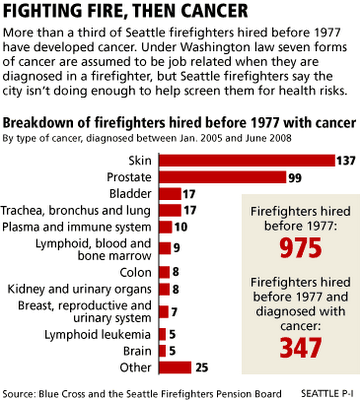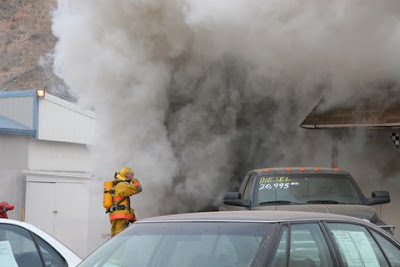Wildfire Today has covered cancer among firefighters previously, but more information continues to be available about this risk. Here is an excerpt from an article in the Seattle PI:
==================================================
Cancer takes heavy toll on Seattle firefighters
City defends itself against charge it could do more
By KATHY MULADY AND CASEY MCNERTHNEY
P-I REPORTERS
Dave Jacobs started fighting fires when he was 20. It was the only job he ever
wanted. He battled brush fires in California, house fires in Oregon and fires of every kind in more than two decades with the Seattle Fire Department.
Now 57, Jacobs is fighting cancer.
 A year ago he was diagnosed with esophageal cancer. There are days when he can barely swallow a few spoons of soup. The disease has progressed to his liver and lymph system.
A year ago he was diagnosed with esophageal cancer. There are days when he can barely swallow a few spoons of soup. The disease has progressed to his liver and lymph system.
Cancer is a presumptive disease in firefighters — more than a third of Seattle firefighters hired before 1977 have developed some form of the illness. Under Washington law, seven forms of cancer are assumed to be job related when they are diagnosed in a firefighter.
But there are many other cancers that aren’t on the list, forcing men such as Jacobs to prove that their illnesses were job related to get workers’ compensation. Seattle firefighters say the city is not doing enough to help screen them for cancers and other health risks. City officials are sympathetic but question the effectiveness and cost of health screenings.
“My heart goes out to the other firefighters who have yet to be diagnosed,” Jacobs said. “This job is a killer.”
According to the International Association of Firefighters, more union firefighters died of cancer in 2007 than from heart attacks or fire-related injuries combined. Nationally, there were 38 union firefighters who died last year from cancer, 16 from heart attacks and 10 from fire-related causes. That trend is continuing in 2008.
It is assumed that if a Washington firefighter who was on the job for 10 years develops prostate cancer before age 50, or brain cancer, bladder or kidney cancer, malignant melanoma or several others, it was in the line of duty.
In this state, three of five active firefighters who died this year were cancer victims. The other two died fighting California wildfires.
Seattle Battalion Chief James Scragg — a survivor of the deadly Pang warehouse fire — died of lung cancer Jan. 17 at age 54. Seattle firefighter Tim Heelan, 43, also died in January after melanoma spread to his lungs and spine.
Marty Hauer, a Kent firefighter who traveled the nation teaching fitness seminars to other firefighters, stunned colleagues when he revealed that he had thymic carcinoma, a rare thymus gland cancer. He died in June at 41. Dozens of others are fighting the disease.
Of 975 firefighters hired in Seattle before 1977, about 350 have been diagnosed with cancer, and 43 of the men were younger than 60 when diagnosed, according to numbers from the Seattle Firefighters Pension Board.


